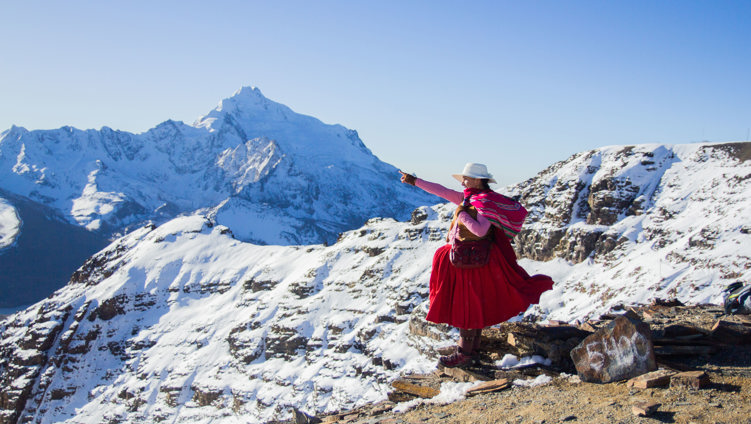Simon Baxter's woodland photography is astonishing. Below is an extended conversation (edited for length) between Simon and our Editor Sam about Simon's slow, local, emotionally attuned process.
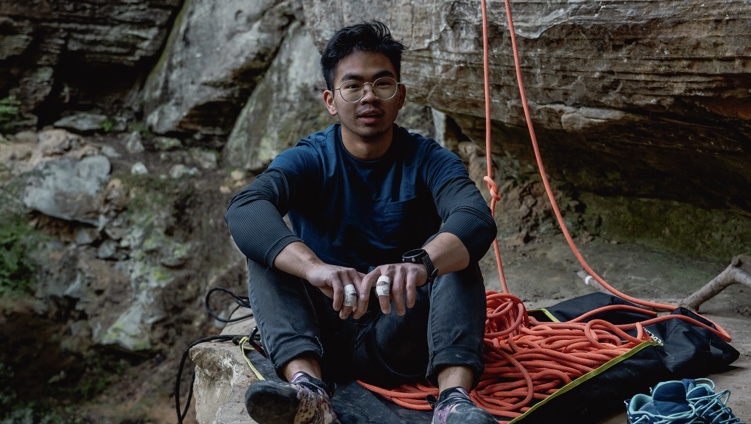
Simon Baxter's woodland photography is astonishing. Below is an extended conversation (edited for length) between Simon and our Editor Sam about Simon's slow, local, emotionally attuned process.
Your upcoming book, Gathering Time, includes a lot of your own writing, which is relatively unusual for a portfolio book. What was the thinking here?
It's largely because my background and how I got back into photography - the experiences I've had and the emotional rollercoaster I've been through - is fundamental to the photography. I'm not interested in the technical side of photography. Obviously it’s important, but it doesn't excite me. It's all about thought, feeling, emotional connection to the places that I choose to photograph. So I wanted to get that across.
For me, nature has been this magical thing that has had a profoundly positive impact on my life. The way I feel now is very, very different to a number of years ago. So there's this burning desire to share that.
Anticipation, Simon Baxter
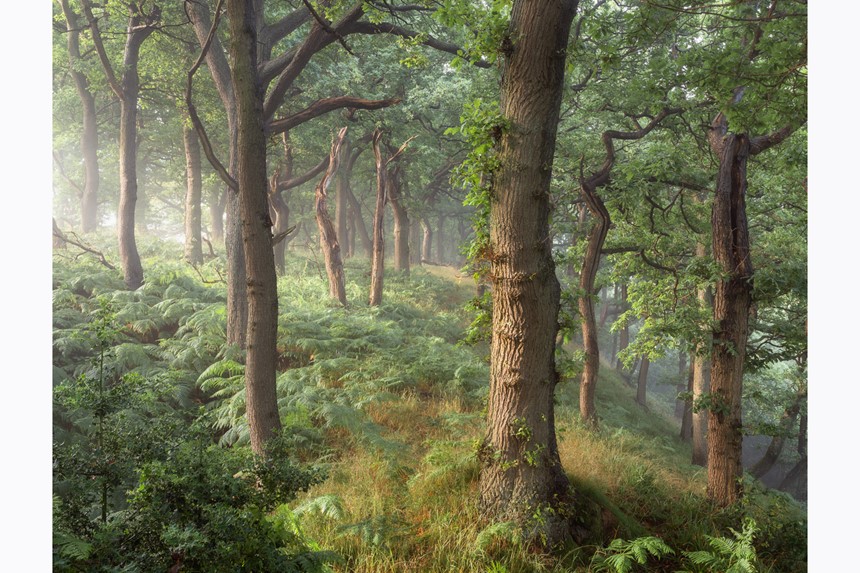
Has the outdoors always played an important role in your life?
We were fortunate enough to grow up in a time when we didn't have iPads, smartphones. We lived in a very small village, and there wasn't much to do. So we went exploring in the countryside: playing in little streams, wandering down to the beach, turning over rocks.
You don’t really see the value of it when you’re a kid. But when we were teenagers we spent a lot of time freshwater fishing. Our approach was to find the most secluded and difficult-to-fish lakes, with the most difficult-to-catch fish. The hobby was almost an excuse to be out in nature. We spent just as much time appreciating the sunrise over the lake. The motto of flyfisher’s club was “there’s more to fishing than catching fish.” That sentiment carried through to mountain biking as well. When there was a blizzard outside, I had a friend who would turn off his phone, because he knew I'd be messaging him saying, “Come on, let’s go out!”
'I had a friend who would turn off his phone, because he knew I'd be messaging him saying, “Come on, let’s go out!”'
But then you developed an injury?
I felt pretty unstoppable really, not considering that a lot of my hobbies involved sitting down: my desk job was sedentary, sitting on a bike, sitting in a kayak. So I was developing these muscle imbalances, but there were no warning signs. I was out for a bike ride one day and got a sharp pain in the bottom of my back. I didn't really think anything of it, but then I got pain in both knees and my legs started to go weak. But I received the wrong physio. They were concentrating on my knees, when actually the issue was in my hips. Then my lower disc ruptured, and the nucleus came out the disc and damaged the nerves a little bit, which left me with this chronic pain.
What role did rekindling and expanding your interest in photography play in responding to the injury?
My partner recognised that I was in a bad place, with a failing business, working from home, always on my own. She suggested we get a dog, Meg, to keep me company. And she just turned everything around, made me smile every single day. We had this wonderful relationship whereby she needed to be eased into the world, and I was still trying to rehabilitate, so we did that together.
I started taking my camera, and at the end of 2015 discovered woodland photography. It was quite a profound experience. I was wandering through a wood one day, and realised that I hadn't thought about pain for an hour, for the first time in three years. My mind was occupied with this complexity - the sights, the smells, the sounds. There's a big difference between exploring and trying to find something and make sense of it rather than being stood on a hillside waiting for the sun to set over an iconic part of the landscape.
Cascade (left) and Community (right), Simon Baxter
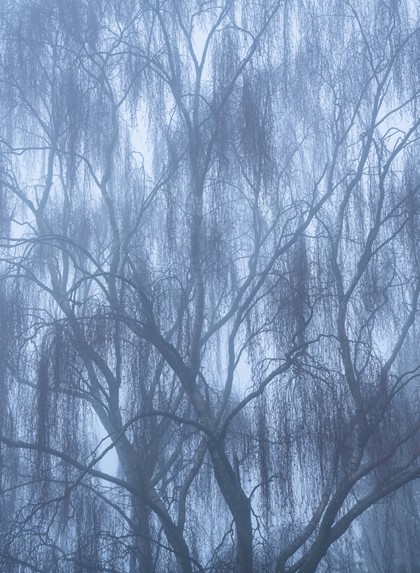
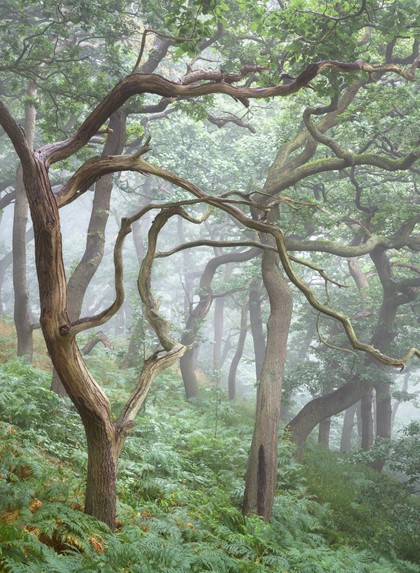
Do you ever find yourself comparing the joys of photography and mountain biking? On the face of it two very different things ...
Photography doesn’t have the same fitness benefits or the adrenaline rush, but there is adrenaline in photography: excitement, anticipation, stepping into a woodland and seeing the most magical conditions.
As with any hobby, it's the mental wellbeing - that opportunity to just put things into perspective. The end result is similar, but I guess with a slower appreciation now. Before the trees were obstacles, fun to ride through, whereas now I see the ecological value, the habitats they support. Learning by having observed trees through the seasons - that's a really satisfying process.
Beyond the complexity, what is it about woodland specifically that draws you in?
After driving for no more than 20 minutes, and walking for ten minutes, I can find myself in a woodland completely disconnected from the rest of civilisation. You can wander in the smallest of places, and it's like a different world. These are places which have never been walked, never mind photographed.
I go for a walk, find somewhere, then spend months exploring that location, finding compositions and wonderful trees and going through the challenging process of trying to make sense of it and waiting for great conditions. It can take years to get the end result that's representative of everything you love about that environment. It’s restorative.
Above: One of Simon's video, on his emotional connection with woodland
In your videos it’s clear that you have a strong emotional connection to the woodland you explore and the trees you photograph. What is the nature of this connection?
It’s tricky, because I want people to find their own emotional connection. I see it as the missing piece, if you like - that bit between spotting something you want to photograph and executing the process. It’s almost impossible to teach.
For me, it started as something instinctive, and I had to mine my own thoughts to try and understand. Why am I photographing these things? Why have I chosen to compose in this way? In those early stages it created a bit of frustration. Then I had this epiphany.
I went back to a tree I had photographed previously. Another photographer, which I admired, had seen a photograph I’d taken of this tree and left a comment saying “exemplary.” I thought, “That's a wonderful comment, but why is it exemplary?” I wasn't in a good place at the time. I was in a lot of pain. I was still trying to deal with a failing web-development business. And I got quite upset.
Distant Dale, Simon Baxter
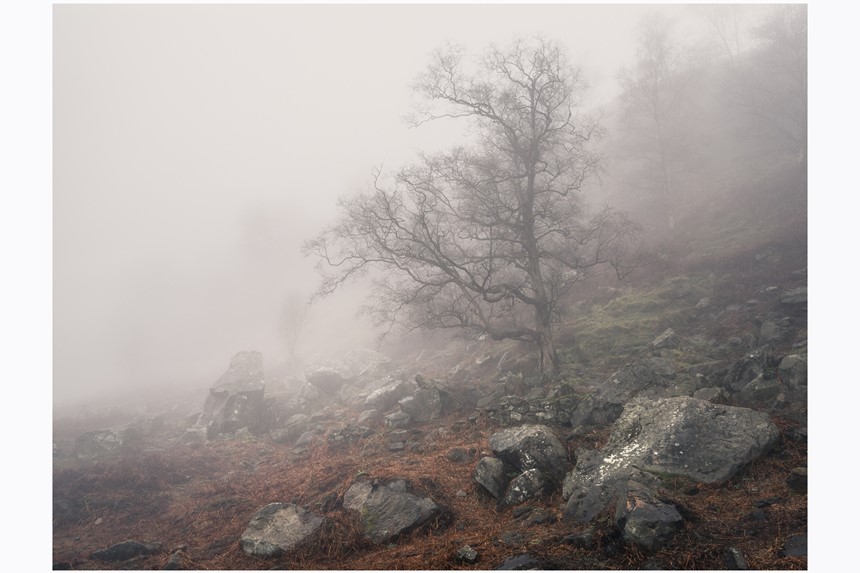
Then I slowly realised what was happening, staring at this tree. I seemed to be photographing a lot of these lone trees with bits hanging off. You’ve got the crumbling landscape, the very somber mood and the murky view. And I started to relate to these trees in a very different way, as a reflection of how I was feeling. I realised it was all about me. The photographs have to be a reflection of me; my emotion had to be wrapped up in the photographs. This isn’t just an endeavour to create something visually striking. It isn't just a photograph; it’s a piece of me to communicate and express what I love.
I started to delve a little bit deeper, and trees and woodland actually became part of my identity. I think the term is biophilia. And when you have that empathy for what you're photographing, it fuels this desire to build your knowledge. No longer is it just a tree. It's a birch. Why is it significant?
'The photographs have to be a reflection of me; my emotion had to be wrapped up in the photographs. This isn’t just an endeavour to create something visually striking. It isn't just a photograph; it’s a piece of me to communicate and express what I love.'
You asked Lucy Jones, author of Losing Eden, to write an essay for Gathering Time on this emotional connection. Why did you find it helpful to ask somebody else to write about this in conversation with your photographs?
The therapeutic benefits of forests are amazing. Shinrin-yoku - Japanese for “forest bathing” - is described as a treatment in some countries. But I have no interest in diving into the science of it, because I can only invest my time and energy in so many things. Lucy and I both went through a dark phase in our lives where nature helped us. So I had that connection with her. But I wanted her contribution to add substance, so it’s not just whimsical, it’s not airy fairy. It adds credibility.
Family Tree, Simon Baxter
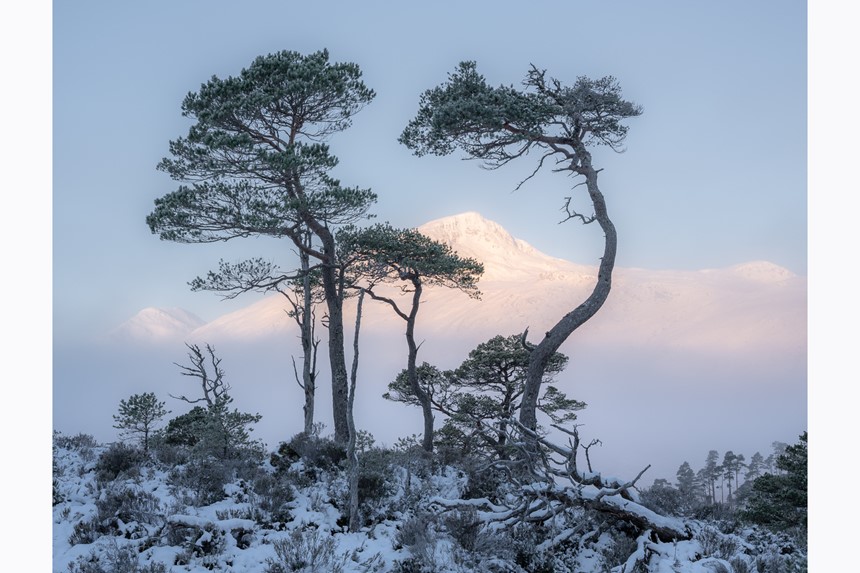
Do you have any images that you feel particularly capture the value of a slow approach to photography?
The journey into Valley Stories III (below) started in March 2016. It was just a standard overcast day. I walked into this little valley and I spotted the scene and I was like, “Wow!” It was just oozing with potential. I took a scouting version in March 2016, and more iterations since. But it was in September 2017 that I went again and got these magical conditions.
The slow process was very valuable, but now the scene no longer exists. The felling has happened and this is all destroyed. There's value in being slow, but don't be too slow. It really highlights the fragility of these places. That in itself is quite powerful. The benefit of shooting locally is that you can keep going back, and it highlights these things. Whereas if it's just weekly trips to some exotic location every now and then, you're never witness to any of this.
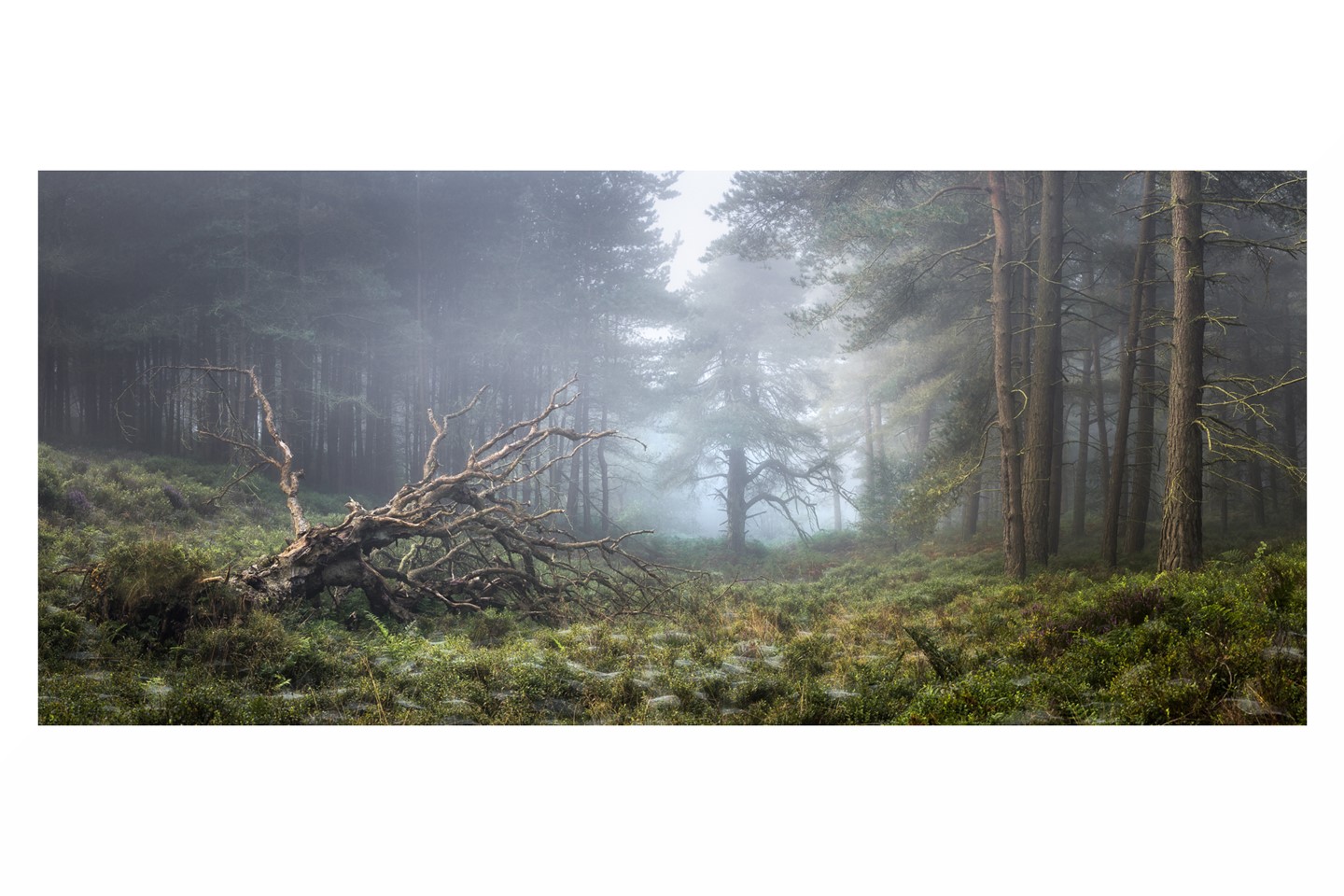
Summer Sanctum is different. I scouted this composition, then got this version a day after. The slow approach here was in crafting the composition. I was inspired by Joe Cornish in terms of the language that we use when we talk about photography. We always hear terms such as ‘snap’ and ‘take’ and ‘shot’, and that instils the thought that everything is done quickly. It sounds pretentious to say that we don't take snaps, we craft or make photographs. But it’s meant to give a mindset that we seek to slow down and have a considered approach with what we're trying to achieve.
If you slow down in the field, and have that contemplative approach and make really tiny, tiny adjustments, you nail the composition in the field. In Summer Sanctum, when you actually look closely beyond the initial overall view, you look at these very micro separations. The way you get this kind of poetic flow, connection and sense of community in the woodland is through very meticulous attention to detail and micro adjustments. It’s wonderful.
Summer Sanctum, Simon Baxter
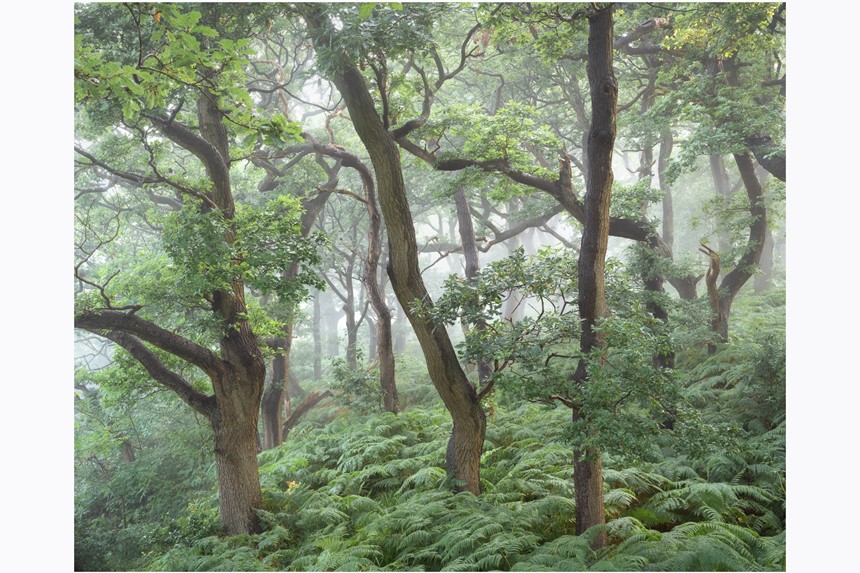
How has your photography evolved in recent years?
I’m moving towards quieter things, and exploring more chaotic images. But also drawing inspiration from different places. I’m teaching myself more about trees and about the ecology of these places. It’s probably going to get a bit depressing, but it brings an opportunity to inform the creative choices. If I can look at a tree and understand a lot more of what's going on, it can inform how I compose it and my intentions. And even though a lot of people might not see that in the end results, it enriches the process, and gives me an opportunity to add narrative to these images in a future project - an opportunity to fire people to connect in a way where they feel as if they really care for these places, and see the value of them in terms of broader environmental issues.
Above: Simon's latest YouTube video
Are there other artists or thinkers that you’ve found have had a particular influence in your own work?
It's tricky, because I don't have the best relationship with social media, so I find myself distancing myself from consuming the work of others through social media. I have a series of books by Colin Bell; he inspired me a lot when I was starting out photographing trees. And Rachel Talibart: she's a friend, shooting photographs of the coast and waves - I really like her approach. I try to consume photography through books by people that I know. I feel happier when I’m in my bubble! There’s a fine line between inspiration and noise that can cloud your judgment. I'm more interested now in conversations with thinkers such as Joe Cornish, in terms of photography, or conversations with people in other disciplines: ecologists, foragers or any other kind of woodland specialists.
Above: A video of Simon's featuring Joe Cornish
YouTube is huge for you. Do you ever experience tensions with that?
I'm incredibly grateful to YouTube and the subscribers to my channel. Without that, I wouldn't be a full-time photographer. So I'm extremely thankful. But at the same time, I'd be lying if I said that it’s without its issues. Some people are quite happy to be a YouTuber, and create lots of content to feed the beast. But I absolutely need time in the woods with just the camera and Meg. The thought of always having to record a video… I would lose the passion.
I've been there before, where I could feel it slipping away. I knew I had to nip it in the bud, because if you cross that threshold, you're absolutely done. So it's a very tricky path to tread. People think it's all about having YouTube fame. But my approach has always been: what happens if YouTube disappears tomorrow? Can I continue as a photographer? That's always been my aim: to better myself as a photographer. And hopefully that will be enough to sustain an income and a business, whether YouTube is there or not.
Above: Simon's first ever YouTube video
Is YouTube, and the YouTube community, forgiving of your need to nip that in the bud?
People stick to a weekly schedule because the audience grows to expect that. So you're more likely to get that consistency in terms of views, and if you’re getting the views, YouTube is more likely to promote your videos and you're more likely to grow. Now YouTube is absolutely saturated with photographers, particularly from the UK, so it's more difficult to stand out and unfortunately, the things that are now promoted aren’t the types of videos I want to make.
Everyone wants their piece of the pie - their Instagram success. The problem that creates is this behaviour where they feel as if they can’t be slow. I’d rather satisfy my core audience and hopefully slowly build that core audience without sacrificing anything that's important to me as a photographer. I've got to be happy in what I do. The consequence is that I'll never reach half a million subscribers, but that's fine. Ultimately, I'd rather my legacy in photography be the number of photography books that I'm really happy with, and that other people respect, rather than people saying, “Oh, yeah, he was the YouTuber that had half a million subscribers.”
